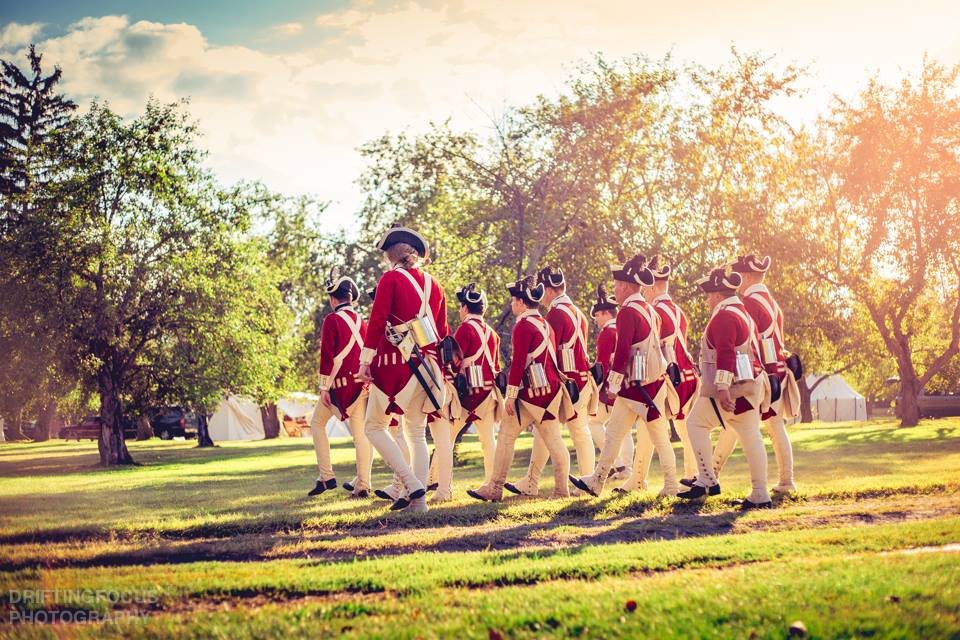
Revisit the best of the blogs from 17th and friends!
"Sprang interlinked:" The Construction of Eighteenth-Century British Army Sashes
This week we are thrilled to welcome Suzannah Emerson from Old Fort Niagara, who kicks off a new element in our continuing blog adventure: interviews. From time to time, we'll be posting the results of questions asked remotely via email or in person to shed light on interesting things happening in the larger living history community. In today's installment, Suzannah explains her recent research and experiments into spranging, opening a window into eighteenth-century fibre arts.-- Will Tatum
Thanks for taking on this interview request, Suzannah. For starters, we hear people saying that sprang is the proper method for constructing officers and sergeants sashes during the eighteenth century, at least for the British Army. So what is sprang anyway?Sprang has a fascinating history! Peter Collingwood’s The Techniques of Sprang (the bible on sprang construction) states it can be dated back as far as the early Danish Bronze age (1700-500BC). Several sprang clothing items were found on the numerous “bog people” who pop up in Northern European countries.
Okay, now mentally prepare yourself for some jargon! Let’s start simply, think of a 3- strand braid; there are only 3 pieces of yarn/hair/whatever (a warp), and there are no new perpendicular pieces (a weft) added to the warp like you see in a weave. Now think of sprang as a very fancy braiding process, one uses his or her fingers to manipulate a series of strands in a particular pattern to form a piece of cloth. Like the braid, there is no weft, only a warp. If you are familiar with some of the wonderful oblique finger-woven products used by Native American reenactors, these are made by a process closely related to sprang. 
From The Techniques of Sprang, pg. 31 the structure of sprang (a) and obliquefinger-weaving (b)
Many people seem to confuse sprang with crocheting. Let’s get this straight right now people; Crochet was not around in the 18th century! The structure of sprang produces a very stretchy fabric. Ye olde spandex anyone? The technically correct term is not “sprang woven” but “sprang interlinked.” The structure of a chain linked fence looks very similar to sprang! It is this interlinking, that makes the stretch possible.

This royal blue striped sergeant sash shows off the stretch and structure of thesprang
Up until the early 21st century, I had never seen a sprang sash for sale. Now we have a lady in Canada making them, and they seem to cost an arm and a leg. Does that have something to do with the difficulty of "spranging," if that is the proper term? What kind of set-up is required to making sprang items?Like many hand-made and finger-woven items, the cost is probably 95% labor. Manipulating over 150 strands to make 8-10ft. of sash takes a good deal of time, and one’s fingers can only move so quickly. There is one beauty to sprang that other fingerweaving processes are not capable of implementing. With the correct setup, with one row of strand manipulation one can achieve two rows of textile. Yes folks, that is sprang one get one free.
Let’s go back to the braid example, if you have ever braided before, you might have noticed that the free ends of the braid can get tangled at the bottom. This tangle is actually the mirror image of the braid you are trying to produce. If your braid were secured at both ends while you were working it, you would find that the work meets in the middle. Sprang production often takes advantage of this two for one deal. If this were not the case, I don’t know if I would have the patience to complete an entire sash. There is one problem with this deal, one side of a sprang project is the mirror image of the other. Therefore, if a mistake is made it shows up twice on the sash. If there is a mirror image structure in a “finger-woven” type item, this is one way to identify sprang. There are three options when setting up (i.e warping) a sprang project, two of which allow for one row manipulation for two construction. The braiding example from earlier is using a “figure-8 warp.” The setup I use for sashes is called a “circular warp,” the advantage here is that I only need a “loom” a little over half the height of my desired project length. This comes in handy when my formidable 5’1” self is trying to make a 10 foot sash. 
Please excuse my poor drawing skills, this image shows two warps used tomake sprang.
The image below shows the heavy duty frame I use. It’s made from two 7-foot tall 2x4s, various dowels, pipes and rods. The top PVC pipe can be moved depending on the desired length of the project, and the bottom pipe can be adjusted for project tension. I could easily make a 12 foot sash using this frame. The vast quantity of yarn necessary for a sash is wound around the two PVC pipes, creating one large yarn circle. After the warp is secured, it’s time to start making sprang!

Sprang “loom” set up for a shorter project, sprang is a very versatile textile.
Recall that one manipulation of the warp produces two rows of sprang. The first row created by a manipulation is pushed up and over the top PVC pipe, and then the second row is pushed down under the bottom. These rows meet in the middle back of the circular warp. The sash itself is actually made from the middle outward! On many original sashes you will see a line across the weave in about the middle of the sash.This is where the first two rows were pushed, and the body of the sash began to form. This is one sign that a textile could have been made using sprang.

The work begins from the middle and works out, the white strings are a safetymeasure in case I mess up, I can take the work out to that point and try again. After I amfinished with the sash the strings are easily removed.

Here I am pointing to the center meeting line of the completed sergeant sash.
I understand you are combining your adventures in making sprang items with examining existing originals. Would you tell us a bit about your research to date: how does one study an original sash? Have you found any interesting insights in your research?I had looked at one original sash before I began my sprang adventures. I noticed that there were some oddities in the products I made, and I had a very difficult time eradicating these issues from my work. Then, I began to have more opportunities to study originals. This is when I discovered that those “oddities” were perfectly normal in original sashes! Through these studies I have answered a great many questions which had come up during my sprang sash productions. Many of them are trivial in the grand scheme of things, but they have made the process more efficient.
One thing which seems to be repeated throughout the study of extant clothing items and accoutrements, and is the same for sprang: many things were not made perfectly. I find a great deal of charm in finding little hiccups in these items.One of the first photos we saw of your sash work was a cat wearing a sash. Can you explain how cat help features in the your process?If you have ever lived with a cat, you will quickly come to realize that they believe you should never be without supervision. My cats certainly follow through on this belief, not only supervising the process, but also checking for quality. 
Waldo checking for yarn strength during the warping process.

Waldo continuing his work by making sure the first few rows are properly carried out. This also shows the circular warp right at the start of production.

Madam doing the final check while the sash is blocked. I no longer use this process to “set” the sprang, but it was an interesting experiment.
What are some of the greatest hurtles you've encountered so far in the research and replication processes?There are two:
My first challenge was finding the materials of the appropriate color, weight, and fiber. I had a hard time finding a “crimson” wool yarn that wouldn’t pill and get fuzzy. Thanks to the weavers at Colonial Williamsburg, I was able to find the Jagger Spun line from Halcyon Yarn. The line is a long staple wool, that pills relatively little. As for silk, this was easier to find. I use the hand-dyed silk yarns from Treenway silks. I have compared the silk yarns from Treenway to several originals, and I believe I have found a near perfect match!My second, and ever-ongoing challenge, is dating the sprang sashes I study, unless we are talking about the Braddock sash, which has “1709” emblazoned on it for all of time. This is unusual, and many sashes have little to no designs that might suggest from when they date. Sure, the curator/collections manager usually has some note on the provenance. Unfortunately, this is usually a statement from someone’s great-great-great Aunt Susie-May who claimed that her great-great Uncle’s 3rd cousin twice removed wore it at Yorktown. Who knows, Aunt Susie-May could be correct, but I have found sashes in collections that could not possibly date to the purported time period.
Therefore, I am cautious but, I believe it is safe to assume that a “crimson” silk plain sprang sash, with no designs is probably appropriate for most 18th British military officer interpretations. This claim also holds for British 1812 impressions.
Do you have any particularly exciting sprang projects on the drawing board?
At the moment, I am focusing on research and the 21st century job market. One question I would like to dive into is what 18th century sprang frames looked like. I have a descent hypothesis, but I would like some more evidence to support my ideas. Also, I hope that in the next few months I’ll be able to exactly reproduce some intricate details I have found throughout my sprang sash studies. Who knows, maybe I’ll make a cat equivalent of the Braddock sash.

Resident cat, Leopold, at Old Fort Niagara wearing my first sprang sash, and acocked hat found at Walmart.
 SUZANNAH EMMERSONcurrently serves as the Special Projects Coordinator and Field Music Supervisor at Old Fort Niagara in Youngstown, NY. She holds a BA in Mathematics from Gettysburg College. When not delving into the secrets and mysteries of numbers, she enjoys fibre arts and exploring eighteenth-century German culture.
SUZANNAH EMMERSONcurrently serves as the Special Projects Coordinator and Field Music Supervisor at Old Fort Niagara in Youngstown, NY. She holds a BA in Mathematics from Gettysburg College. When not delving into the secrets and mysteries of numbers, she enjoys fibre arts and exploring eighteenth-century German culture.

